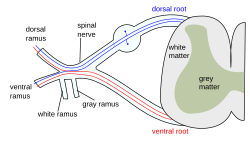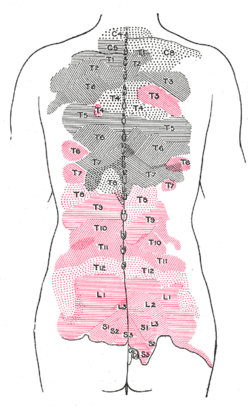Posterior divisions
| Dorsal ramus of spinal nerve | |
|---|---|

Diagram of spinal nerve
|
|

Areas of distribution of the cutaneous branches of the posterior divisions of the spinal nerves. The areas of the medial branches are in black, those of the lateral in red.
|
|
| Details | |
| Identifiers | |
| Latin | ramus posterior nervi spinalis |
| Dorlands /Elsevier |
r_02/12691733 |
| TA | A14.2.00.035 |
| FMA | 5983 |
|
Anatomical terms of neuroanatomy
[]
|
|
The dorsal ramus of spinal nerve (or posterior ramus of spinal nerve, or posterior primary division) is the posterior division of a spinal nerve. The dorsal ramus (Latin for branch, plural rami ) is the dorsal branch of a spinal nerve that forms from the dorsal root of the nerve after it emerges from the spinal cord. The spinal nerve is formed from the dorsal and ventral rami. The dorsal ramus carries information that supplies muscles and sensation to the human back.
Shortly after a spinal nerve forms from the dorsal and ventral roots of the spinal cord it branches into the dorsal ramus and ventral ramus. Spinal nerves are mixed nerves that carry both sensory and motor information. It also branches to form the grey and the white rami communicates which make connections with the sympathetic ganglia.
After it is formed, the dorsal ramus of each spinal nerve travels backward, except for the first cervical, the fourth and fifth sacral, and the coccygeal. Dorsal rami divide into medial, intermediate, and lateral branches. The lateral branch supplies innervation to the iliocostalis muscle, as well as the skin lateral to the muscle on the back. The Intermediate branch supplies innervation to the spinalis muscle and the longissimus muscle. The medial branch supplies innervation to the rest of the epaxial derived muscles on the back (including the transversospinales, intertransversarii muscles, interspinalis muscles, and splenius), and the zygapophyseal joints.
...
Wikipedia
